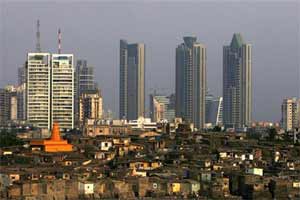After nearly 25 years, Mumbai may see a change in the floor space index (FSI) ceiling as the state readies a new development plan for the city.
To make real estate in Mumbai more affordable, especially in the residential segment, the Brihanmumbai Municipal Corporation (BMC) is set to invite suggestions from the public even as Sitaram Kunte, its municipal commissioner, has hinted at increasing the FSI limit.
The base FSI, or the permissible construction on a plot of land, is 1.33 for the island city between Cuffe Parade and Mahim. For the suburbs — starting from Bandra and stretching till Virar on the western side, Sion and upwards towards Kalyan, Thane — the base FSI is 1.
However, urban planners and consultants say the current FSI in Mumbai has not been scientifically assessed — the norms, they say, are not comparable globally and not even with other Indian cities.
While Shanghai has an FSI of 13, the number is 15 for both New York and Manhattan. In Pune, seen as a shadow of Mumbai until recently, FSI is 1.5 for old city areas and 2.5 for MHADA schemes. The FSI available for slum rehabilitation schemes is up to 5.5. There is also a plan to increase FSI to 4 in metro corridors.
In Delhi, FAR (floor area ratio) is calculated as a percentage unlike standard ratios in other major cities. In November, the urban development ministry had approved the increase in FAR in Delhi from 150% to 200% for plots of 750-1000 square metres, and raised it to 200% from 120% for plots of 1,000 square metres and above.
In Bangalore, FSI is calculated according to the size of the plot and road width. It ranges from 1.75 for plot sizes of up to 3,875 sq. ft with road width up to 40 ft, to 3.25 for a plot area higher than 43,050 sq. ft and road width beyond 100 ft.
Calling the current FSI norms “archaic”, Sulakshna Mahajan, urban planner, Mumbai Transformation Support Unit (MTSU), said the development and availability of infrastructure have not gone hand in hand in the city, leading to lopsided developments.
“The city needs a scientific assesment of FSI and a single blanket FSI across the city will not be correct. The present thinking seems to be that development and infrastructure availability should go hand in hand and we are hopeful that the upcoming development plan will address some of the current issues,” Mahajan said. MTSU is an initiative of the World Bank, Cities Alliance, USAID, All India Institute of Local Self-Government and the Maharashtra government to facilitate the process of Mumbai’s transformation.
The biggest pitch for a higher FSI has been coming from real estate developers, who argue that a higher FSI would mean lower prices for the end consumer.
Sumesh Mishra, executive vice-president (finance), Sunteck Realty, said: “The land cost in most pockets of MMR (Mumbai Metropolitan Region) is as high as Rs 5,000- 7,500 per square foot, then there are additional charges developers incur on TDR, which range at Rs 3,000-3,500 sq. ft. So, with this extra FSI, the blended land cost would be lower by at least Rs 1,000-1,500 per sq. ft for the developer, which would help in giving buyers affordable prices as well as improving developers’ margins.”
Dharmesh Jain, managing director, Nirmal Lifestyle, says that as the city is land- locked, going vertical is the only way to create volumes, which will bring in affordability. “There is very little space left for more development in Mumbai and if the state government wants to address the issue of affordability, going vertical is the only way forward. However, we also hope that there is co-existence of open spaces as well as development.”
Despite developers’ optimism, there is scepticism on whether an increase in the FSI limit will actually bring down real estate prices in Mumbai.
Divya Seth Maggu, general manager (valuation & advisory services), Colliers International, says, “There is unlikely to be a blanket increase in FSI and it will vary across locations. In such a scenario, passing on the benefits of cost that may accrue with the increase in FSI will be on the developers, which they may or may not pass on.” However, Maggu adds that a higher FSI in south Mumbai areas like Nariman Point or even BKC will be beneficial, provided the allied infrastructure, like coastal road and metro projects, are developed simultaneously or even before the increase in FSI comes in.
The change to the FSI rules becomes even more important as the current regime was formulated aiming that the population of Mumbai will be 75 lakhs in 2011. However, according to the 2011 census, the city’s population was 1.8 crore, more than double of what was estimated to be housed.


